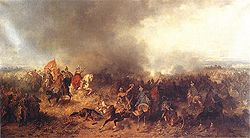- Polish–Ottoman War (1620–1621)
-
Polish–Ottoman War 1620–1621 Part of Polish–Ottoman Wars 
Battle of Khotyn, by Józef BrandtDate 1620–21 (Treaty of Khotyn) Location Moldavia Result Indecisive Territorial
changesStatus quo Belligerents  Poland-Lithuania
Poland-Lithuania Ottoman Empire
Ottoman EmpireCommanders and leaders Jan Karol Chodkiewicz †
Wladyslaw WazaOsman II The Polish-Ottoman War (1620–21) or First Polish-Ottoman War was a conflict between the Polish–Lithuanian Commonwealth and the Ottoman Empire over the control of Moldavia. It ended with the Commonwealth withdrawing its claims on Moldavia.[1]
Contents
Background
From the end of the 16th century and the beginning of the 17th century, the magnates of the Polish-Lithuanian Commonwealth intervened in the affairs of Moldavia, which the Ottoman Empire considered within its sphere of influence. Additionally, the Ottomans were aggravated by the constant raids of Cossacks, then nominally subjects of the Commonwealth, across the border into Ottoman territories.
The war
At the time, the Thirty Years' War was raging across Europe. The Commonwealth was relatively uninvolved in this war but the Polish king, Zygmunt III Waza, sent an elite and ruthless mercenary unit, the Lisowczycy, to aid his Habsburg allies. They defeated the Transylvanian lord George I Rákóczi at the Battle of Humenné in 1619, and prince Gabriel Bethlen of Transylvania asked Sultan Osman II for aid.
Then Gaspar Graziani, ruler of Moldavia, switched sides and joined Poland. Thus, the sultan agreed to help Bethlen, gathering a large Ottoman army with the intent of a punitive invasion of the Commonwealth. In 1620, he crushed the Commonwealth army at the Battle of Ţuţora (Cecora). The campaign was suspended for the winter but, in 1621, both sides resumed hostilities.
In 1621, an army of 100,000–250,000 soldiers (sources vary), led by Osman II, advanced from Constantinople and Adrianople in April, towards the Polish frontier. The Polish army had 8,280 hussars, 8,200 Cossack cavalry, 1,400 Lisowski cavalry, 2,160 western cavalry, 6,800 Polish infantry, 5,800 western infantry, 800 Hungarian infantry and 25,000 Zaporozhian Cossacks.
The Turks, following their victory in the Battle of Ţuţora, had high hopes of conquering Ukraine (then a part of Poland), and perhaps even toppling the Commonwealth entirely and reaching the Baltic Sea. This time, however, they were stopped by a Commonwealth army, aided by a large Cossack detachment, at the Battle of Khotyn. The ensuing peace treaty resulted in no border change but the Commonwealth agreed to stop its interference in Moldavia. Both sides claimed victory, as the Commonwealth saw the battle of Khotyn as a successful stopping of the Ottoman invasion of its mainland and the Ottoman Empire achieved its goal of removing the impending threat on the Moldavian lands.
The Polish–Ottoman border would remain relatively peaceful until the Polish–Ottoman War (1633–34) and the Polish–Ottoman War (1672–76).
Notes
References
- (Polish) Wojny polsko-tureckie, Encyklopedia WIEM
External links
- Polish Warfare: 1618–1621 War with Turkey
- (Polish) Wojna 1620–1621
- (Polish) WOJNY POLSKO TURECKIE W PIERWSZEJ POŁOWIE XVII WIEKU
Categories:- 1620s conflicts
- Wars involving Poland
- Wars involving the Ottoman Empire
- Wars involving the Grand Duchy of Lithuania
- History of Poland (1569–1795)
- History of Lithuania (1569–1795)
- Warfare of the Early Modern era
Wikimedia Foundation. 2010.



